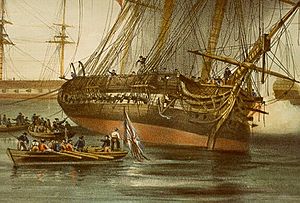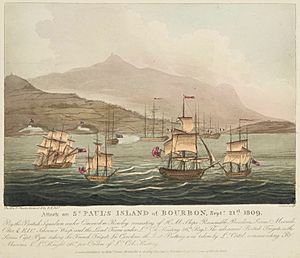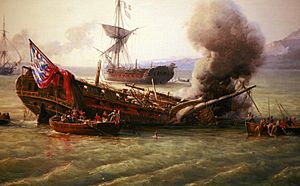HMS Sirius (1797) facts for kids

HMS Sirius stranded on a coral shoal. Lithograph by A. Meyer (National Maritime Museum, London)
|
|
Quick facts for kids History |
|
|---|---|
| Ordered | 30 April 1795 |
| Builder | John Dudman, Deptford |
| Laid down | September 1795 |
| Launched | 12 April 1797 |
| Honours and awards |
|
| Fate | Destroyed by fire (scuttled), 25 August 1810 |
| General characteristics | |
| Tons burthen | 104659⁄94 (bm) |
| Length | 148 ft 10 in (45.4 m) (gundeck); 124 ft 0+1⁄8 in (37.8 m) (keel) |
| Beam | 39 ft 10 in (12.1 m) |
| Depth of hold | 13 ft 3 in (4.0 m) |
| Sail plan | Full-rigged ship |
| Complement | 247 officers and men |
| Armament |
|
HMS Sirius was a 36-gun fifth-rate frigate of the Royal Navy. She was built in 1797 and served during the Napoleonic Wars. Sirius was known for helping to blockade Europe. She was lost in 1810 during the Battle of Grand Port when her crew had to sink her after she got stuck.
Contents
Building the Sirius
The British Navy ordered the Sirius to be built on April 30, 1795. Her main frame, called the keel, was laid down in September 1795. She was officially launched on April 12, 1797. The design for the Sirius class of ships was based on a Spanish ship called the San Fiorenzo, which the British had captured in 1794.
Battles in Europe
Sirius began her service in May 1797 under Captain Richard King.
Capturing Dutch Ships
On October 24, 1798, Sirius had her first big action. She captured two Dutch frigates, the Waakzaamheid and the Furie, near the Texel.
The Waakzaamheid had 24 guns and 100 Dutch sailors, plus 122 French soldiers. She was carrying many weapons. This ship surrendered without a fight.
The Furie had 26 guns and a crew of 153 Dutch sailors and 165 French soldiers. She was also carrying many weapons. The Furie fought Sirius for about 30 minutes. Sirius had only one sailor injured, while Furie had eight men killed and 14 wounded.

More Captures
Sirius continued to be busy. In November, she helped capture a French brig and a sloop. On January 6, 1800, she was part of a group of ships that captured the French brig Ursule.
Later, on June 12, Sirius and another ship, HMS Indefatigable, captured a French privateer named Vengeur. A privateer was a private ship allowed by the government to attack enemy ships. Vengeur had 16 guns and 102 men. She had captured an English ship the day before.
Sirius also recaptured several merchant ships that had been taken by French privateers. For example, on July 3, she recaptured the brig Cultivator, which was sailing from Demerara to London.
On December 11, Sirius captured the Spanish merchant brig Melchora off the coast of Spain.
Capturing the Dédaigneuse
On January 26, 1801, Sirius joined other British frigates, HMS Oiseau and HMS Amethyst, in chasing a French frigate called Dédaigneuse. On January 28, Oiseau and Sirius successfully captured the French ship. The Dédaigneuse was then added to the Royal Navy as HMS Dedaigneuse.
Napoleonic Wars
When fighting with France started again, Sirius helped blockade the French port of Brest. A blockade means stopping ships from entering or leaving a port.
More Prizes
In May and June 1803, Sirius captured several French ships, including Mere de Familie, Achille, Trois Freres, and Aigle. Capturing enemy ships meant the crew would receive prize money.
Sirius also helped recapture British ships that had been taken by the enemy, like the Lord Nelson and the Perseverance.
Battle of Cape Finisterre
On July 22, 1805, Sirius took part in the Battle of Cape Finisterre. This was a naval battle between the British fleet and a combined French and Spanish fleet. Sirius helped capture two Spanish ships, the St. Raphael and the Firme.
Battle of Trafalgar
On October 21, 1805, Sirius joined the famous British fleet led by Vice Admiral Lord Nelson at the Battle of Trafalgar. This was one of the most important naval battles in history. Sirius fought close to Nelson's flagship, HMS Victory.
After the battle, the British Parliament gave a large sum of money to be shared among the sailors who fought. Years later, in 1847, surviving sailors from the battle received a special medal called the Naval General Service Medal with a "Trafalgar" clasp.
Sirius vs. Bergère
In April 1806, Captain William Prowse of Sirius learned that a French force had sailed from Civitavecchia towards Naples. He quickly chased them and caught up near the Tiber River. The French force included a ship, three smaller warships, and five gun-vessels. They were waiting for Sirius near a dangerous shallow area.
The battle began at 7 PM and lasted for two hours. Sirius fought bravely, and the main French ship, the Bergère, surrendered. The Bergère was a strong ship with 18 guns and 189 men. Captain Prowse said she was a "remarkably fine Vessel." Sirius lost nine men killed and 20 wounded in this battle. For this action, the sailors also received a special medal clasp: "Sirius 17 April 1806."
After repairs, Captain Samuel Pym took command of Sirius in November 1808. He sailed her to the Cape of Good Hope and the Indian Ocean.
Indian Ocean Operations
On March 2, 1809, Sirius captured a French schooner called Mecontent. In August, Sirius joined a group of British ships led by Commodore Josias Rowley.
Raid on Saint-Paul
On September 21, 1809, Sirius took part in an attack on Saint-Paul, on the island of Réunion. During this attack, Sirius and HMS Raisonnable captured the French frigate Caroline. This ship was then added to the British Navy. The British also recaptured several valuable merchant ships that Caroline had taken. Sirius had two marines killed and two wounded during this raid.
In the summer of 1810, the British began a campaign to capture French islands in the Indian Ocean. They took Île Bourbon (now Réunion) in July. Then, they focused on Mauritius.
Battle of Grand Port
The British tried to land troops at Grand Port in Mauritius to destroy French defenses. However, two French frigates, Bellone and Minerve, and a corvette called Victor, entered the harbor and took up strong defensive positions. The French also moved the channel markers to confuse the British ships.
On August 23, 1810, the British squadron entered the channel. Sirius was the first ship to run aground, meaning she got stuck on the seabed. Two other British ships, HMS Magicienne and HMS Néréide, also got stuck. HMS Iphigenia wisely anchored further away. The French ships then focused all their fire on the stuck British ships.
The battle continued all night. On August 24, the French boarded the damaged Néréide. Magicienne and Sirius kept fighting, but by evening, the crew of Magicienne had to abandon their ship and set it on fire.
Loss of the Sirius
The crew of Sirius tried everything to free their ship, but she was stuck fast and taking on water. Captain Pym ordered that all her supplies be moved to HMS Iphigenia. Once this was done, the crew left the Sirius on the morning of August 25, 1810. As they left, they set fire to her. Sirius exploded around 11 AM, and her hull briefly floated off the reef before sinking.
The Battle of Grand Port was a big victory for the French. They captured two English frigates (Iphigenia and Néréide) and destroyed two others (Sirius and Magicienne). They also took 1,600 prisoners. This battle is known as the only French naval victory of the Napoleonic Wars.
What remains of the Sirius
Today, the wreck of Sirius lies in about 20 to 25 meters (65 to 82 feet) of water. The ship broke apart over time, partly from being scuttled and partly from people trying to salvage parts of it. However, the site is still important for archaeologists, and many of her cannons can still be seen on the seabed.
Images for kids





